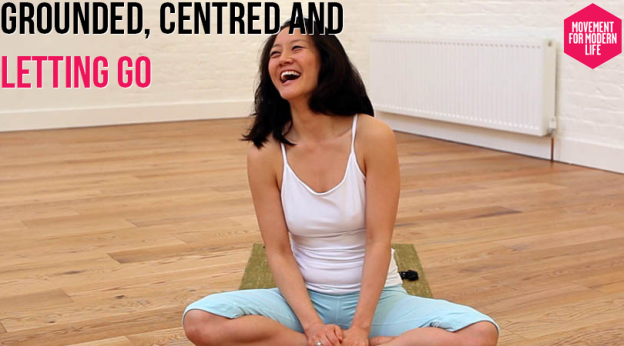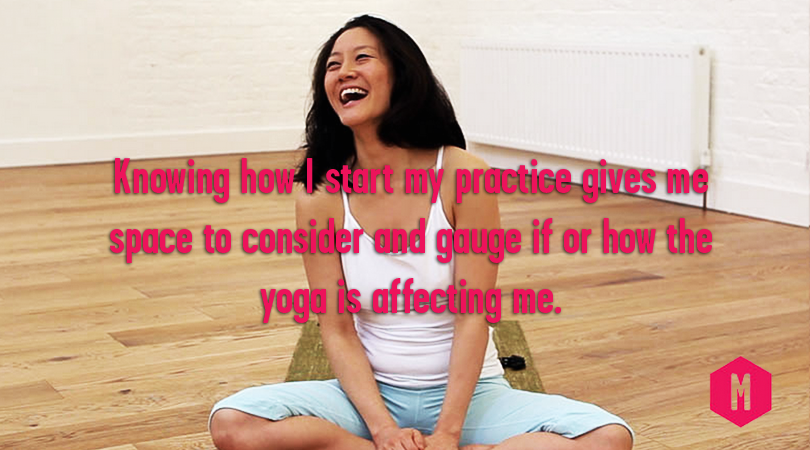When I start any yoga practice, I often begin by asking myself how I feel physically and mentally.
It’s often easy to judge myself based on what I find, especially when I feel wildly out of balance, which has been fairly often this year – on average, I took an overseas trip at least once a month for family health emergencies; the travel, hospitals and care giving certainly took a toll. When I notice myself being a bit harsh or judgmental, however, I worked toward softening my tone, and simply observing what’s there: do I feel tired? Steady? Ungrounded? Anxious? Happy? Scattered? Focused? Clear?
Knowing how I start my practice gives me space to consider and gauge if or how the yoga is affecting me. Depending on the day, after a few sun salutations I’ll tend to feel a bit lighter and more energized. Sometimes after the focus of standing postures, my center feels stronger, and I feel steadier on my feet. Deeper into my practice I might witness how my breath somehow dismantles the hungry fatigue lurking around the back of my heart. By noticing the effect of my practice, I feel like the yoga offers interesting insights into to who I am, and how I might not always have to work with just the grumpy, tired, stressed aspects of myself. I can also feel vibrant, open, and more free. This is not only good for me; surely my husband, students and friends will also appreciate a less prickly-mannered me!
The word yoga comes from the Sanskrit root word yuj, which means “to yoke.” Since its first written appearance thousands of years ago in the Vedic text the “Ṛgveda”, yoga has been defined in different ways: some interpret it as devotion, others as discipline; some as union, others as connection or even transformation. One definition offered by the author of the “Yoga Sutra,” Patanjali, is that yoga is the stilling or quieting of the busy mind. The yoking process is therefore a reining in of the tendency for our conscious mind to be externalized. The mind quiets and abides in a state of deeper, internal awareness, which opens one to a see more clearly into the true nature of things. It is a practice of being awake and tuned-in to what’s happening in the present moment. Our gateway to the present moment on the yoga mat is the attention and listening we offer our body and space for each breath.
As Richard Freeman, a well-respected Ashtanga yoga teacher writes, “Yoga begins with listening.”
Though I sometimes love some crazy dancing or cardiovascular exercise that gets my heart rate going (lately I am back into a good fast-paced jump rope routine!), I’ve found that with yoga, mindful, steady movements and physically centering practices help me focus, and that focus begins to even out the ripples of my busy mind.
Through concentrating on my breath and the alignment of my body, some space opens up to just be. The attention we grant our moment-to-moment experiences is what enriches the process of yoking and deepens our yoga practice to a new level. Tuning in to a more centered, steady, quiet space often lets me remember there’s a part of me that is whole, clear, and vibrant – even though at times this part of myself feels obscured by the drama of everyday life. It reminds me of what my main teacher, Erich Schiffmann wrote in the opening page of his book: “The purpose of yoga is to facilitate the profound inner relaxation that accompanies fearlessness. The release from fear is what finally precipitates the full flowering of love.
In this state you will love what you see in others, and others will love you for having been seen. This is the softened perception of the world that yoga promotes.” A yoga practice that centers and grounds, like the one I’ve offered this week on MovementforModernLife.com, has been deeply healing for me. I find I can relinquish the things that don’t really serve me – tension, fatigue, or confusing thoughts that try and take hold and usurp me. It lets me remember that it’s possible to let go and just be. On my mat, I remember that despite the challenges and difficulties I face, life can feel fresh and poetic as well. It takes time, but the simple benefits of yoga that accrue with time and a regular practice can change stuck patterns and help awaken the potential for living a full, passionate and spirited life.
Sounds good right? Join Mimi for a yoga class today.
 Mimi mainly teaches a breath and alignment-based vinyasa yoga that is cross-pollinated with aspects of Daoist and Buddhist teachings. In 2002, Mimi co-founded Yoga Yard, Beijing’s first and leading yoga studio, which she co-directed for seven years. She now lives in London, and teaches classes, workshops and retreats in the UK and internationally.
Mimi mainly teaches a breath and alignment-based vinyasa yoga that is cross-pollinated with aspects of Daoist and Buddhist teachings. In 2002, Mimi co-founded Yoga Yard, Beijing’s first and leading yoga studio, which she co-directed for seven years. She now lives in London, and teaches classes, workshops and retreats in the UK and internationally.
http://www.mkdeemer.com/






Pingback: Making Mistakes and Moving On - Movement For Modern Life